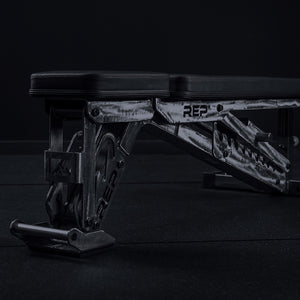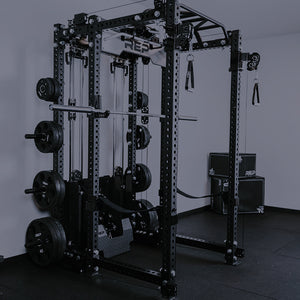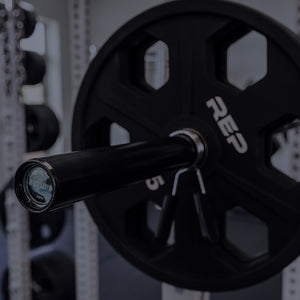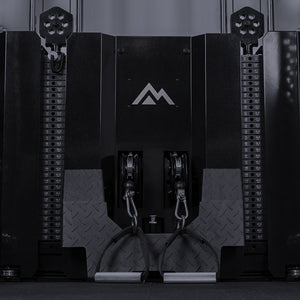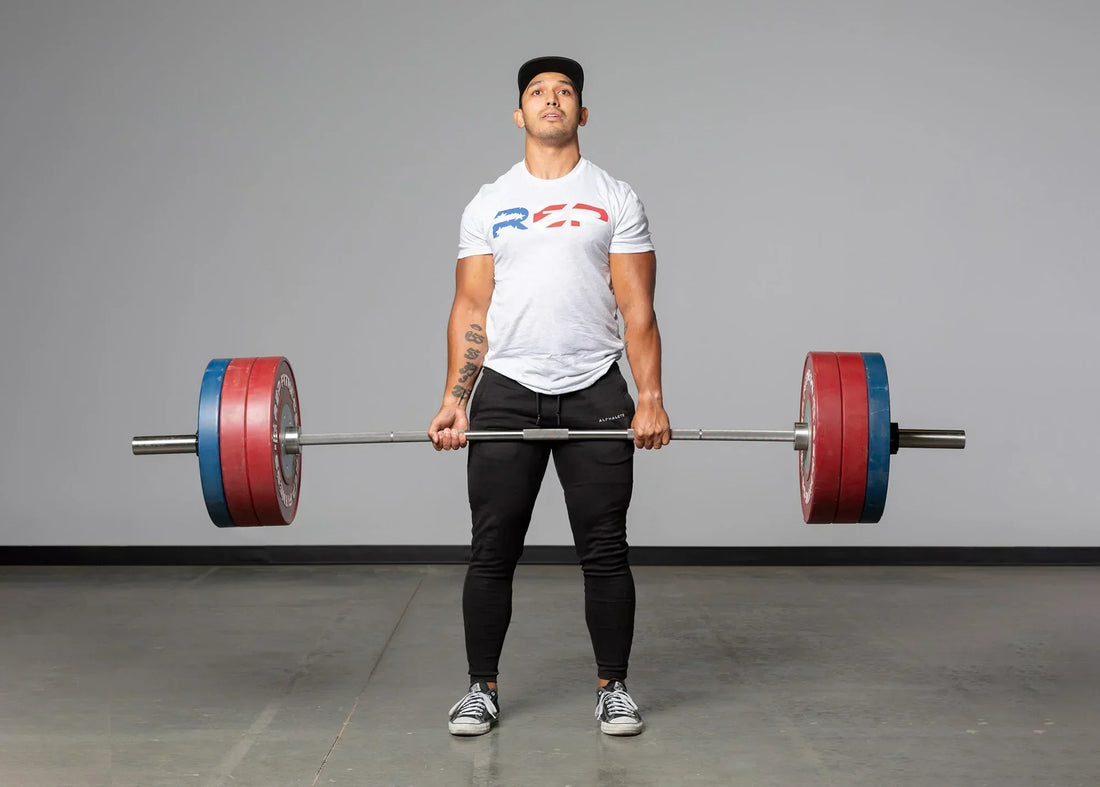
Stacy “Bama” Burr started small, but she ended big: with the best wrapped Wilks score of all time in powerlifting. When Burr hung up her competitive knee wraps in 2019, she was the actual GOAT, with a 668.2 Wilks and a crown as the all-time world-record holder in the 148lbs class. It all started with a spot on her South Carolina property, where she pieced together a home powerlifting gym on a tight budget.
Burr knows how to build an at-home powerlifting gym; she’s done it herself three times in three different states. We'll tackle the pieces of equipment she recommends.

Bama Burr teaching a lifting workshop. Photo by Adam Rivera
What is Powerlifting?
Powerlifting is a strength sport focused on three main lifts: the squat, bench press, and deadlift. The goal is to lift the maximum possible weight for a single repetition in each lift.
Unlike Olympic weightlifting, which involves explosive movements, powerlifting emphasizes raw strength and controlled technique. Competitions are divided by weight class, age, and experience level, with lifters getting three attempts per lift to achieve their highest total. Whether for competition or personal progress, powerlifting is a great way to build strength, improve muscle endurance, and test physical limits.
Building a Powerlifting Gym

Compared with bodybuilding, powerlifting training is pretty straightforward. It centers around a squat, bench, and deadlift – all barbell lifts. Your accessory lifts are going to require other kinds of equipment, but exactly what equipment you use is pretty flexible. The specifics will vary based on your program, personal needs, and preferences.
Here’s the Queen of 148’s advice on how to build an at-home powerlifting gym, in order of priority: what you definitely need – and also what you might want to add, either now or as you build out your space in the future.
1. A QUALITY POWER RACK

First and foremost, you need a rack.
“A versatile power rack is definitely #1,” Burr says. Two-thirds of your competition lifts can be done in a power rack, so picking the right one is key. When making your selection, you’ll want to look at:
- Weight capacity: Make sure your rack can grow with you. Even REP’s simplest rack, the PR-1000, can handle 700lbs, all the way up to the commercial-grade PR-5000, with a rackable capacity of 1,000lbs.
- Size of the rack: Make sure it fits in your space and you have room to move inside and outside the cage.
- Versatility: What can you add to your rack in terms of attachments and spotter arms? A versatile rack saves you space and is easy to add to and grow with.
- Organization: A rack with built-on weight storage horns removes the need to buy a separate weight tree.
- Safety: Make sure your power rack comes with J-cups and safeties (all REP racks do).
- Hole spacing: Different power racks have different distances between the holes in the uprights, where you place your J-cups (and other attachments). If you need a specific liftoff height for bench, look for a rack with closer hole spacing throughout the bench zone, like the PR-4000.
Pro Tip: If building the PR-4000 or PR-5000 in your gym, consider having REP's rack socket set handy to simplify the process.
2. A BENCH
You can’t bench without a bench. Duh. While competition bench is only done on a flat bench, Burr recommends choosing an adjustable bench (or incline bench) with flexibility for your accessories.

“An adjustable bench allows you to work in different planes of motions,” Burr says. “You can change the angles and range of motion and have a lot more access to different exercises. Even if you just change the angle slightly, that can totally modify an exercise.”
The AB-4100 is great for competitive lifters because it has three posts: two by your head and one by your feet, so the feet of the bench won’t get in the way of your own feet when you’re setting up/driving through. The AB-4100 also meets IPF height standards, so you’re training how you’ll compete. As an adjustable bench, it goes both ways: flat and incline bench, with seven total back positions and three seat positions.
3. A BARBELL

Your barbell is your bestie as a powerlifter. The Double Black Diamond Power Bar checks all the boxes. IPF markings let you train on a competition-style barbell, and a weight rating of 1,500lbs means it’s tough enough for even the world’s strongest deadlifter. Bronze bushings allow for consistent rotation, while ensuring incredible strength and stiffness to withstand heavy loads.
Or if you’re a deadlift specialist or powerlifter who really loves that aggressive knurling and extra bend, check out the Hades Deadlift Bar.
4. WEIGHT PLATES
A set of weight plates is really the last must-have for a simple, at-home powerlifting gym. Sanctioned powerlifting meets use calibrated kilo plates, and it’s most common for powerlifters to use iron plates over bumpers. The most accurate iron plates are Equalizer ™ Plates, which weigh within 2% of their stated weight.

However, competitive powerlifters may want to stick to the irons, Burr says. The biggest issue with thicker plates is how they spread the weight farther out on the barbell, she says. This changes the way you take the slack out of the bar and also changes the distribution of weight. Thin, competition plates are much more compact, which actually adds difficulty to the lift. Yeah, it’s subtle -- “but you’ll feel a difference, especially when working in that top 1% end,” she says.
If you’re a competitive powerlifter wanting to control as many training variables as possible (and not be unpleasantly surprised on the platform), go iron.
5. CLIPS

Oh yeah, make sure you get some simple clips or clamps to hold your plates on the bar. Spring Clips are cheap and easy to use.
Nothing sexy or nuanced here.
6. DUMBBELLS

Now that you have the five must-haves for a powerlifting gym, it’s time to think about accessory exercises. A set of dumbbells was the next piece of equipment Burr got for her OG gym. The barbell is a bilateral piece of equipment, so it’s important to also train unilaterally to correct any weaknesses or imbalances between your sides. Dumbbells also demand more stability than a bar, Burr says, and they’re incredibly versatile for all muscle groups.
If you only train flat bench and the bar misgrooves in a meet, you won’t have the other muscles to help you correct the lift, and you’re going to lose it, Burr says.
“If we’re not hitting a movement from different angles, we’re leaving meat on the bone,” she says. If you're tight on space, go with a set of adjustable dumbbells.
7. BANDS

Yes, one of the baddest baddies on the platform puts resistance bands way high on her priority list – and for good reason. You can use them for warm-ups and mobility, and attach them to Band Pegs on your power rack and use them as a tool to provide additional resistance. If you don’t have the budget or space for a cable machine, resistance bands can fill in those gaps, too.
8. A FUNCTIONAL TRAINER/CABLE MACHINE

Just like dumbbells, a cable machine is versatile and helps build overall muscularity, which all comes together for the Big Three. However, unlike dumbbells, cables provide constant tension, so you can isolate the muscle more. Cables also allow you to do nearly infinite accessories – with less impact and CNS fatigue.
No, a cable machine isn’t a die-hard necessity for a powerlifting gym, Burr says, but it helps you do more total work.
“Especially in your off-season, you’re not always going to want to do only barbells – your body won’t always be recovered and ready to hit those compound moves,” she says. Cables let you keep training, without overtraining the same movements and muscles in the same way.
If you have limited space, Burr recommends a cable attachment that fits inside or attaches neatly to your existing power rack.
9. A LANDMINE ATTACHMENT

A Landmine Attachment is versatile as heck: T-bar rows, Meadow rows, overhead presses, tricep extensions, chest press. What makes it unique is it’s loaded from the bottom, creating a different plane of motion, says Burr.
“Across the board, you’ll never meet somebody strong with a big back who has never done a T-bar row,” Burr says. And as the saying goes, “Big back, big total.”
10. A BELT SQUAT

This one goes out to the lower body. Next in Burr’s home gym was a Belt Squat Attachment. This allows you to load the lower body with less spinal compression than a barbell squat, so it’s easier to recover from. This can mean more frequency in your lower-body training with less fatigue.
“You’re still training the squat pattern, but the central nervous system can recover quicker, and your body will appreciate that,” she says.
11. AN AB ROLLER

The last high-priority item on Burr’s powerlifting wish list is the Ab Roller. “A lot of powerlifters say they train their core doing squats, bench, and deadlifts – which is true,” Burr says. “But this trains the core in a way that is really helpful in terms of those deep ab muscles that will help the big three more than just surface-area crunches.”
That’s because the Ab Roller targets your transverse abs in a way no other equipment does, she says. She learned this firsthand at the Sweatt Shop gym in Cincinnati. At the time, she was pulling 525lbs. Owner Shane Sweatt told her to start training her abs with the Ab Roller every day – and she says it worked. She ended up pulling 550 to top off her 1,435lbs total. Did the Ab Roller do it all for her? No, of course not.
“But if you think about it, if your core or base is stronger, of course it’ll have an impact on your main lifts,” she says. “That’s something people overlook. For like $10, you can add that in, it doesn’t take up a ton of space, and it doesn’t require much time. But if you do that, your lifts will improve – and I’ll sign off on that one.”
ADDITIONAL CONSIDERATIONS FOR YOUR AT-HOME POWERLIFTING GYM

Gym Chalk or Liquid Chalk to help with deadlift grip.

Fractional Plate Set (especially helpful for bench jumps).

Floor Mats. Some people use heavy-duty floor mats instead of or in addition to a deadlift platform to protect their floors.
How to Start Powerlifting?
To start powerlifting, focus on mastering the three main lifts: squat, bench press, and deadlift.
- Begin with proper technique using lighter weights before gradually increasing resistance.
- Follow a structured program that balances strength progression, accessory exercises, and recovery.
- Investing in essential exercise equipment like a sturdy power rack, barbell, and plates will help you train effectively at home.
- Prioritize good form, track your progress, and consider working with a coach or experienced lifter for guidance.
Whether training for competition or personal strength goals, consistency and patience are key to success in powerlifting.
Want More Inspiration?
Here are the best gifts for powerlifters.
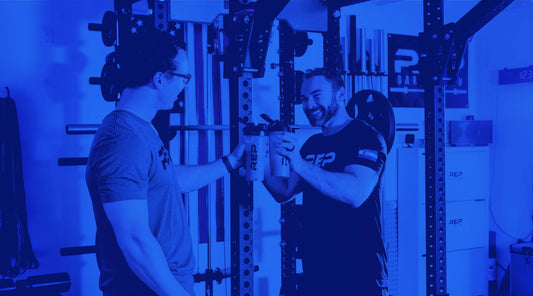
NEWSLETTER SIGNUP
Product launch information, promotions, blogs, and REP news.



